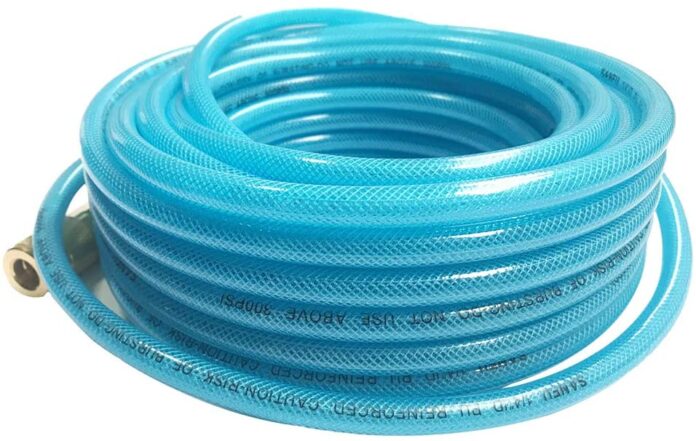When selecting air hoses for a particular project or application, it is important to consider the type of material used to make it. The factors to be considered when choosing a material are the environmental settings, operating conditions, kink resistance, weight, storage ease and capacity, and durability.
Some of the commonly used air hoses are made of materials such as rubber, neoprene, nylon, polyurethane, plastic, PVC, and hybrid ones, among others.
Let us take a look at how rubber and polyurethane air hoses fare against each other.
Durability
Polyurethane air hoses are one of the most durable materials. They have a low drag force, i.e. polyurethane air hoses can resist damage even if the hose is pulled across rough or sharp surfaces.
When compared to polyurethane, rubber air hoses are softer and will tear easily.
Flexibility
Rubber hoses score well in the flexibility quotient; it is easy to roll and store a rubber air hose for this reason.
Though polyurethane hoses can be rolled easily, it does not create a smooth circular wrap and are less flexible than rubber.
However, even in colder temperatures, the flexibility of both hoses is not lost.
Kink-Resistance
Rubber hoses are more likely to kink and also have a kink memory.
Polyurethane hoses, though they kink, have zero kink memory.
Operating conditions
Operating conditions like temperature and pressure play an important role in deciding which air hose is better. The pressure rating of polyurethane hoses is 160 PSI, while a rubber hose is rated at 150 PSI.
A polyurethane hose can be used from a temperature range of -40°F to 165°F. A rubber hose fares slightly better and has the capacity to withstand a longer range of temperature, i.e., -40°F to 190°F without losing its flexibility.
Bulkiness
Polyurethane hoses are the most lightweight air hoses available.
Rubber hoses are heavier and bulkier than any other material options; in fact, rubber hoses weigh twice as much as polyurethane hoses. For this reason, rubber hoses are best for use in a static location, like a garage or workshop.
Non-marking
Polyurethane hoses are 100% non-marking, i.e., the hoses will not leave a mark on clean surfaces.
Being a softer material, there are chances that a rubber hose can sometimes leave marks on surfaces or on your hands. This is because rubber attracts dirt that sticks on them.
Price
Polyurethane hoses are more expensive than rubber hoses.
Storage capacity
Rubber is a thicker material than polyurethane; so even if both the materials provide the same inner diameter, rubber hoses additional weight means you can only store lesser length on the hose reel. For example, the maximum capacity of a 5/8″ standard reel of rubber hose is only 100 feet when compared to 150 feet of polyurethane hose with the same ID.
So, which is better – rubber or polyurethane air hose?
If you need a flexible, easy to roll up hose that does not kink and has the capacity to withstand a longer range of temperature, a rubber air hose is a better choice.
If a durable and lighter hose with low drag force is what you need, a polyurethane hose is a better option.
To take a look at our extensive choice of affordable air hoses that are available in different materials, log on to our website.


